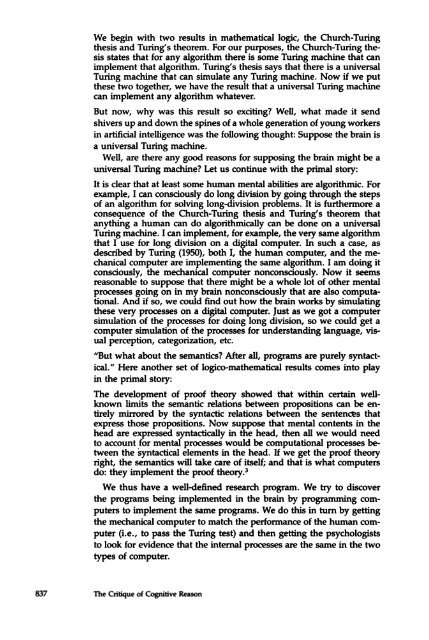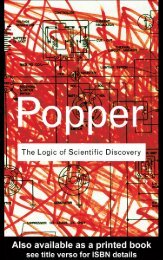John R. Searle - The Critique of Cognitive Reason
John R. Searle - The Critique of Cognitive Reason
John R. Searle - The Critique of Cognitive Reason
Create successful ePaper yourself
Turn your PDF publications into a flip-book with our unique Google optimized e-Paper software.
We begin with two results in mathematical logic , the Church - Turingthesis and Turing' s theorem . For our purposes , the Church - Turing thesisstates that for any algorithm there is some Turing machine that canimplement that algorithm . Turing' s thesis says that there is a universalTuring machine that can simulate any Turing machine. Now if we putthese two together , we have the result that a universal Turing machinecan implement any algorithm whatever .But now , why was this result so exciting ? Well , what made it sendshivers up and down the spines <strong>of</strong> a whole generation <strong>of</strong> young workersin artificial intelligence was the following thought : Suppose the brain isa universal Turing machine.Well, are there any good reasons for supposing the brain might be auniversal Turing machine? Let us continue with the primal story :It is clear that at least some human mental abilities are algorithmic . Forexample, I can consciously do long division by going through the steps<strong>of</strong> an algorithm for solving long -division problems . It is furthermore aconsequence <strong>of</strong> the Church - Turing thesis and Turing' s theorem thatanything a human can do algorithmically can be done on a universalTuring machine. I can implement , for example , the very same algorithmthat I use for long division on a digital computer . In such a case, asdescribed by Turing ( 1950), both I, the human computer , and the mechanicalcomputer are implementing the same algorithm . I am doing itconsciously, the mechanical computer nonconsciously . Now it seemsreasonable to suppose that there might be a whole lot <strong>of</strong> other mentalprocess es going on in my brain nonconsciously that are also computa -tional . And if so, we could find out how the brain works by simulatingthese very process es on a digital computer . Just as we got a computersimulation <strong>of</strong> the process es for doing long division , so we could get acomputer simulation <strong>of</strong> the process es for understanding language, visualperception , categorization, etc." But what about the semantics? After all , programs are purely syntactical. " Here another set <strong>of</strong> logico -mathematical results comes into playin the primal story :<strong>The</strong> development <strong>of</strong> pro<strong>of</strong> theory showed that within certain wellknownlimits the semantic relations between propositions can be entirelymirrored by the syntactic relations between the senten~ s thatexpress those propositions . Now suppose that mental contents in thehead are expressed syntactically in the head, then au we would needto account for mental process es would be computational process es betweenthe syntactical elements in the head. If we get the pro<strong>of</strong> theoryright , the semantics will take care <strong>of</strong> itself; and that is what computersdo: they implement the pro<strong>of</strong> theory . 3We thus ' have a well - defined research program . We try to discoverthe programs being implemented in the brain by programming computersto implement the same programs . We do this in turn by gettingthe mechanical computer to match the performance <strong>of</strong> the human computer(i .e., to pass the Turing test) and then getting the psychologiststo look for evidence that the internal process es are the same in the twotypes <strong>of</strong> computer .837 <strong>The</strong> <strong>Critique</strong> <strong>of</strong> <strong>Cognitive</strong> <strong>Reason</strong>





